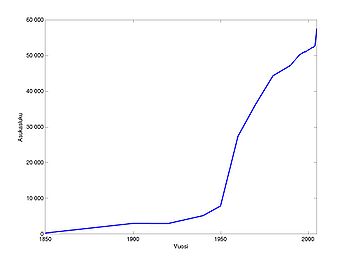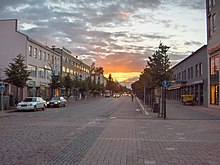Joensuu
| coat of arms | map |
|---|---|

|

|
| Basic data | |
| State : |
|
| Landscape : | North Karelia |
| Administrative community : | Joensuu |
| Geographical location | 62 ° 36 ′ N , 29 ° 46 ′ E |
| Surface: | 2,751.13 km² |
| of which land area: | 2,381.83 km² |
| of which inland waterways: | 369.30 km² |
| Residents : | 76,551 (Dec. 31, 2018) |
| Population density : | 32.1 inhabitants / km² |
| Municipality number : | 167 |
| Language (s) : | Finnish |
| Website : | www.jns.fi |
Joensuu [ ˈjɔɛnsuː ] is a city in eastern Finland with 76,551 inhabitants (as of December 31, 2018). It is the administrative center and by far the largest city in the countryside of North Karelia . In addition to the city center, the 2381.8 km² urban area of Joensuu includes an extensive rural hinterland up to the Russian border. Joensuu is the thirteenth largest city in Finland. Joensuu also has a university, the University of Eastern Finland .
geography
Geographical location
Joensuu is located in the center of North Karelia in eastern Finland, 437 km northeast of the capital Helsinki . The city center is located at the mouth of the Pielisjoki River and Lake Pyhäselkä , which is part of the Saimaa lake system. After its location, Joensuu got its name, which means "estuary" in German.
Expansion of the urban area
Since the incorporation of the municipalities of Tuupovaara and Kiihtelysvaara in 2005, Joensuu has had a very asymmetrical urban area. To the west is the actual city of Joensuu. Before the incorporation it had an area of 120.3 km², of which 81.9 km² was land. Over 90% of the population live in this area. Most of the urban area with an extension of 1312.1 km² (of which 1173.4 km² land) is taken by the extremely thinly populated area of the former municipalities of Tuupovaara and Kiihtelysvaara to the east.
On January 1, 2009, the neighboring communities Eno and Pyhäselkä were also incorporated. This increased the total number of residents to around 72,000.
City structure
The city of Joensuu consists of 28 numbered districts. Districts I to IV make up downtown Joensuu. The last three districts emerged after the incorporation from the area of the former municipalities Kiihtelysvaara and Tuupovaara.
|
|
|
|
Neighboring communities
The neighboring municipalities of Joensuu are Tohmajärvi and Pyhäselkä in the south, Liperi in the west and Kontiolahti , Eno and Ilomantsi in the north. In the east lies the state border with Russia . Together with the surrounding municipalities of Eno, Ilomantsi, Kontiolahti, Liperi, Outokumpu , Polvijärvi and Pyhäselkä, Joensuu forms an administrative community .
history
The area of Joensuu has been inhabited since the end of the last Ice Age, as proven by archaeological finds in Mutala (approx. 5210 BC) and Siihtala (approx. 3860 BC). The water level of Lake Saimaa rose slowly due to the meltwater from the glaciers. After all, it was ten meters higher than today's water level and almost the entire area of Joensuu was covered with water until the water masses around 3000 BC. BC created a drain with the Vuoksi River and the water level sank again. A Bronze Age and Iron Age settlement near Varaslampi has been preserved from the time after the water subsided.
In the Middle Ages, the waters were important traffic routes. A trade route ran through the Joensuu area from Novgorod via Lake Ladoga and Lake Saimaa and Pielisjoki to Pielinen and from there on towards Oulujoki and the White Sea . In the 12th to 14th centuries, settlement spread from the eastern parts of Karelia to North Karelia, but the area of Joensuu initially remained uninhabited. From there, the Orthodox faith also expanded . Around 1530 an Orthodox monastery was founded in Kuhasalo near Joensuu. This was destroyed in a Swedish-Russian war at the end of the 16th century.
Already during the Swedish rule from 1618 to 1809 there was a small village called Joensuu at the mouth of the Pielisjoki. The city of Joensuu but was in 1848 at the behest of Tsar Nicholas I founded. At the same time, the Joensuu Canal was dug to avoid a rapids on the Pielisjoki. After the Saimaa Canal was completed in the 1850s and connected to the railway network in 1894, the city developed into a trading center and grew rapidly. At the time of Finnish independence in 1917, Joensuu was already the largest city in North Karelia. Joensuu has long been an important location for the timber and forest industries, and the forest industry and rafting in the region has made the city an industrial center. In 1918 the Penttilä sawmill, the largest sawmill in the Nordic countries, started operations in Joensuu. Nowadays, other industries have become more important.
In the Finnish civil war , Joensuu was on the side of the bourgeois "whites", but there was no fighting in the city. Joensuu also remained largely unaffected by World War II. In 1954 the population of the city doubled with the incorporation of Pielisensuu . In the 1990s, Joensuu gained dubious fame as the center of the Finnish skinhead movement. The trigger for this was the high unemployment after the Finnish economic crisis and the settlement of civil war refugees from Somalia . In 2005 the area of Joensuu increased by the addition of the rural communities of Kiihtelysvaara and Tuupovaara . In addition, at the beginning of 2009, the municipalities of Eno and Pyhäselkä were incorporated into Joensuu.
Population development
Development of the population
- 1850: 284
- 1900: 2.984
- 1910: 4,789
- 1920: 4,946
- 1930: 5.196
- 1940: 5.146
- 1950: 7,845
- 1960: 27,383 (after incorporation of Pielisensuu)
- 1970: 36.281
- 1980: 44,325
- 1990: 47.215
- 2000: 51,514
- 2004: 52,659
- 2005: 57,587 (after incorporation of Kiihtelysvaara and Tuupovaara)
- 2016: 75,848
politics

Despite losses, the strongest political force in Joensuu remains the Social Democrats . Since the local elections in 2017, they have made up the largest parliamentary group with 15 out of 59 MPs. This is followed by the country's other two major parties, the Center Party with 12 and the conservative-liberal National Collection Party with 9 seats. The right-wing populist base Finns suffered losses and now occupy 5 seats. Also represented in the city council are the Green Bund with 9, the Left Alliance with 6 and the Christian Democrats with 3 MPs, all of whom were able to improve
Composition of the city council after the 2017 election:
| Political party | Share of votes | G / V | Seats | G / V |
| Social democrats | 24.5% | - 2.9 | 15th | - 2nd |
| Center Party | 20.6% | - 0.8 | 12 | - 1 |
| Collection party | 15.8% | - 1.1 | 9 | - 1 |
| Base fins | 9.0% | - 4.1 | 5 | - 3 |
| Green covenant | 14.2% | + 4.0 | 9 | + 3 |
| Left alliance | 10.0% | + 3.9 | 6th | + 3 |
| Christian Democrats | 4.8% | + 0.7 | 3 | + 1 |
P / L: profit or loss compared to 2012 election
Culture and sights
Cityscape
The right-angled street network in downtown Joensuu was designed by the architect Claës Wilhelm Gyldén in 1848 . The street network with wide avenues corresponds to the urban planning ideals of the Empire period and served fire safety. The street Rantakatu follows its name ("embankment street") according to the bank of the Pielisjoki River. There is a green area between the road and the river. Both the Lutheran and the Orthodox Church are on top of a hill. They are connected by the park-like avenue Kirkkokatu. This is cut by a second leafy avenue, the Siltakatu.
Originally the structure of Joensuu consisted of low wooden houses. This ensemble lasted well into the 1960s. From the 1970s, almost all historic wooden houses in the city center were replaced by modern high-rise buildings.
Attractions
The modern city offers relatively few sights, but is the starting point for a visit to the Orthodox monasteries Uusi-Valamo and Lintula . A good hour's drive away is the Koli National Park. The North Karelian Museum (in the “Carelicum” tourist center) is also worth seeing .
More attractions in Joensuu
- Joensuu Areena (multi-purpose hall made of wood)
- Metla-Haus (wooden office building)
- Town hall (designed by Eliel Saarinen)
- Art museum
- Taitokortteli arts and crafts district
- University Botanical Garden
- Neo-Gothic church building by the architect Josef Stenbäck from 1903
Summer festivals with rock concerts take place in Joensuu every year. B. Ilosaarirock , or theater performances take place.
Economy and Infrastructure
economy
Wood processing is of economic importance. The region around Joensuu is one of the structurally weaker regions in Finland. In 1990 the unemployment rate in North Karelia was 7.5%, by 1995 it had risen to 21.9% after the economic crisis, while it was 3.4% and 17.2% in Finland as a whole.
traffic
The city is 508 km from Helsinki by train. In addition, there are daily connections with the Finnish capital from Joensuu Airport .
Education and Research
The university , which was founded in 1969 and now has 8,200 students in eight faculties, is significant .
A prominent point in the cityscape is the North Karelian Central Hospital ( Pohjois-Karjalan keskussairaala ), which is located on a hill above the city and is responsible for the inpatient care of the population of North Karelia (all medical departments, academic teaching hospital).
Town twinning
-
 Hof (Saale) , Germany (since 1969)
Hof (Saale) , Germany (since 1969) -
 Linköping , Sweden (since 1940)
Linköping , Sweden (since 1940) -
 Ísafjörður , Iceland (since 1948)
Ísafjörður , Iceland (since 1948) -
 Tønsberg , Norway (since 1948)
Tønsberg , Norway (since 1948) -
 Vilnius , Lithuania (since 1970)
Vilnius , Lithuania (since 1970) -
 Petrozavodsk , Republic of Karelia , Russian Federation (since 1994)
Petrozavodsk , Republic of Karelia , Russian Federation (since 1994)
Personalities
sons and daughters of the town
- Rolf Nevanlinna (1895–1980), mathematician
- Heikki Savolainen (1907-1997), apparatus gymnast
- Hannu Mikkola (* 1942), rally driver
- Seppo Repo (* 1947), ice hockey player
- Pentti Matikainen (* 1950), ice hockey player, official and coach
- Lauri Mononen (1950–2018), ice hockey player
- Riitta Myller (* 1956), politician (SDP)
- Markku Kyllönen (* 1962), ice hockey player
- Kirsi Hänninen (* 1976), ice hockey player
- Henri Häkkinen (* 1980), marksman
- Esa Lehikoinen (* 1986), ice hockey player
- Mari Eder (* 1987 in Eno , who was independent until 2009 ), biathlete and cross-country skier
- Matias Laine (* 1990), racing driver
- Amanda Pilke (born 1990), actress
- Solomon Duah (* 1993), football player
- Juuso Riikola (* 1993), ice hockey player
- Members of the Humppa group Eläkeläiset
- Members of the metal band Insomnium
Died in Joensuu
- Olavi Kuronen (1923–1989), ski jumper
Web links
Individual evidence
- ↑ Maanmittauslaitos (Finnish Land Surveyors): Suomen pinta-alat kunnittain January 1, 2010 . (PDF file; 194 kB)
- ↑ Statistical Office Finland: Table 11ra - Key figures on population by region, 1990-2018
- ↑ Karjalainen: Suur-Joensuu syntyy ( Memento of the original from January 19, 2008 in the Internet Archive ) Info: The archive link was inserted automatically and has not yet been checked. Please check the original and archive link according to the instructions and then remove this notice. (Finnish)
- ↑ Finnish Ministry of Justice: Result of the 2017 local elections
- ↑ Town twinning page within the website of the city of Hof (accessed on September 7, 2010)

